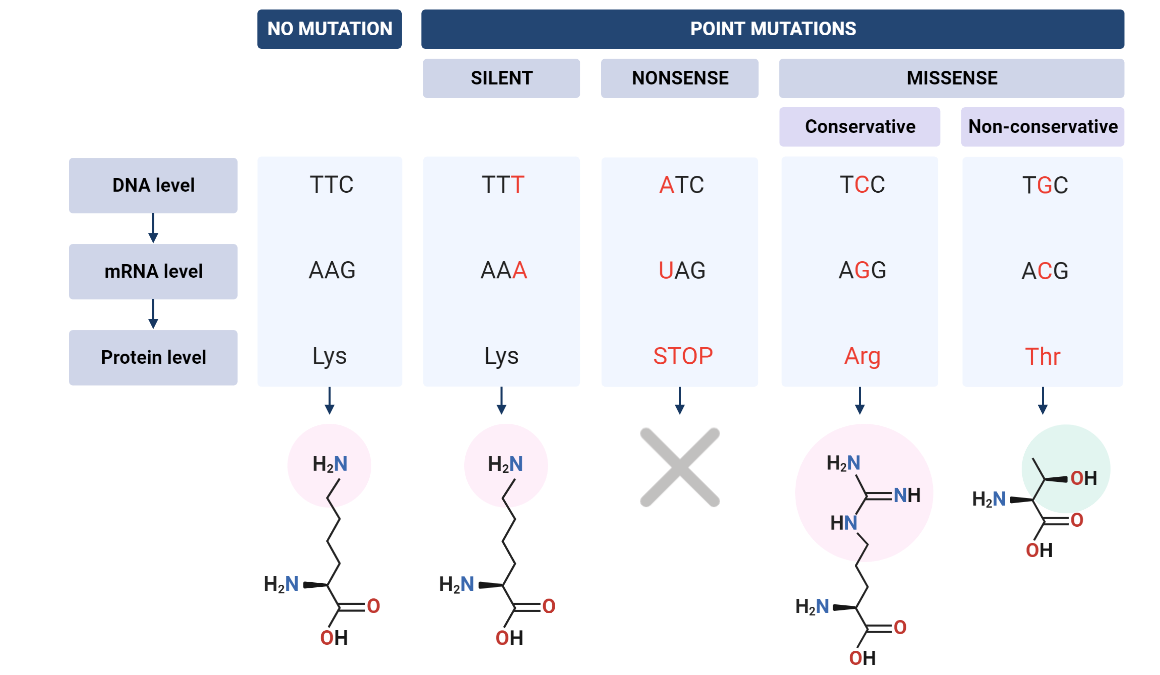Table of Contents
Introduction
- A mutation is a change in a cell’s DNA sequence that can happen randomly or as a result of exposure to particular environmental variables.
- Mutations can happen anywhere in the DNA and alter one or more nucleotides.
- Mutation can have a wide range of effects on the organism’s function and phenotype.
Types of Mutation
A point mutation occurs when a single nucleotide in the DNA sequence is changed.
- Point mutations are classified into three types:
- Silent mutation: a point mutation that does not alter the amino acid that a gene produces. The transition from C to T at the codon TGC, which codes for Cysteine, is an example of this type of mutation; this mutation results in TGT, which still codes for Cysteine.
- Missense mutation: a point mutation that alters the amino acid that a gene produces. The transition from C to T at the codon TGC, which codes for Cysteine, is an example of this type of mutation; this mutation results in TGA, which codes for a stop codon.
- Nonsense mutation: a point mutation that results in a stop codon and a shortened protein. A transition from C to A at the codon TGC, which codes for Cysteine, results in TAG, which codes for a stop codon.
Frameshift mutation
When one or more nucleotides are added to or taken away from the DNA sequence, this is called a frameshift mutation.
- Frameshift mutations can have serious consequences for protein function because they change the gene’s reading frame, resulting in a changed amino acid sequence.
- A single nucleotide deletion in the middle of a codon is an example of this type of mutation; this changes the reading frame and results in an entirely different amino acid sequence.
Chromosomal mutations
There are various forms of chromosomal mutations, which include:
Deletion: the removal of genetic material from a chromosome Down syndrome is caused by the deletion of a part of chromosome 21.
Duplication: an extra copy of a chromosomal region Angelman syndrome is caused by the duplication of a part of chromosome 15.
Inversion: a reversal of the order of a chromosomal segment. A rare genetic condition can result from the inversion of a part of chromosome 9.
Translocation: the transfer of a segment of one chromosome to another. A rare genetic condition can result from the translocation of a part of chromosome 22 to chromosome 9.
Causes of mutation
Mutations can develop spontaneously as a result of mistakes in DNA replication or repair.
Among these faults are:
Base substitution: a change from one nucleotide to another.
Nucleotide insertion or deletion: the addition or deletion of one or more nucleotides.
Exposure to some environmental conditions, such as radiation or toxins, can potentially trigger mutations.
These variables can generate mutations by:
- Directly damaging DNA.
- Interfering with the replication or repair of DNA.
The Influence of Mutation
Neutral effect: Some mutations have no effect on the organism’s phenotype.
These changes can happen in parts of the DNA that don’t code for proteins or in parts that don’t change how the protein made by a gene works.
Beneficial effect: In some situations, mutations might be advantageous to the organism. These mutations may confer a selection benefit, such as disease resistance or a greater capacity to live in a particular environment. This type of mutation is the sickle cell mutation in the haemoglobin gene, which confers malaria resistance in those who carry one copy of the mutation.
Deleterious effect: The majority of mutations have a detrimental effect on the organism, which is referred to as a “detrimental effect.”
- These mutations can induce genetic abnormalities or diseases, or they can lower an organism’s fitness.
- The cystic fibrosis mutation in the CFTR gene is an example of this sort of mutation, which results in a dysfunctional chloride channel and the development of thick, sticky mucus in the lungs, digestive tract, and other organs.
Conclusion
- Mutation is a natural process that can have a wide range of impacts on an organism’s DNA sequence, protein function, and phenotype.
- The type and location of a mutation can have a big effect on an organism’s ability to live and reproduce.
- Understanding the causes, effects, and mechanisms of mutation is critical in fields such as genetics, medicine, and evolutionary biology.
